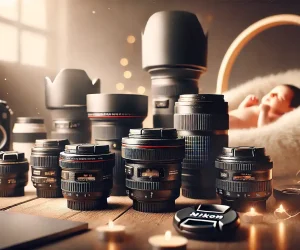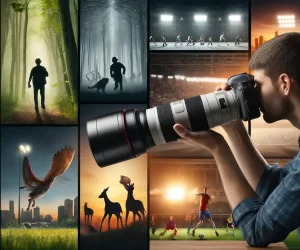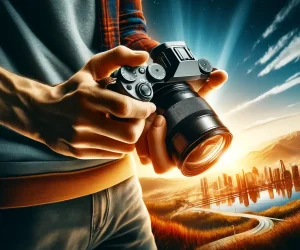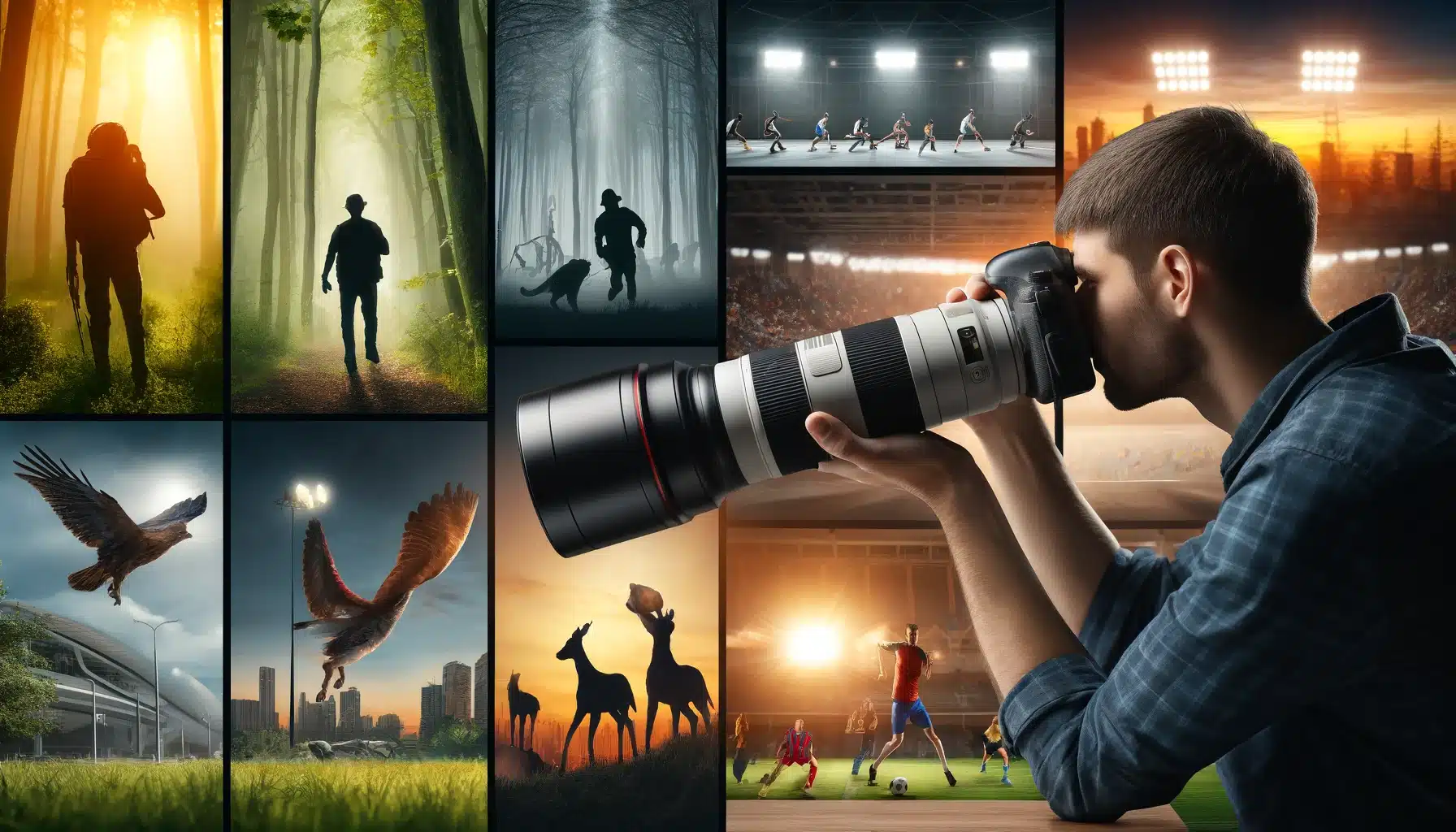
A tele photography lens is a type of camera lens with a long focal length, capturing distant subjects with magnification. It’s ideal for wildlife, sports, and portrait photography, offering greater reach and detail. Embarking on the quest for the best telephoto lens to buy can be as exhilarating as it is daunting. Whether you’re zooming in on distant wildlife, capturing the intensity of sports action, or isolating your subject with a stunning portrait, the right tele photography lens can elevate your photography to new heights.
In this comprehensive guide, we’ll navigate the myriad of options, from the robust build and image quality of Canon and Nikon to the innovative designs of Sony and Tamron, ensuring you make an informed decision that aligns with your photographic vision and needs.
Join us as we delve into the realm of the Best Telephoto Lens to Buy, where each click of the shutter brings the distant and elusive within reach.
Table of Contents
Key Features of Tele Photography Lenses
Below, you’ll find a comprehensive table highlighting the key features inherent in it. By examining these features closely, photographers can make informed decisions when they want to buy the ideal lens for their specific needs and preferences.
| Feature Category | Description |
|---|---|
| Focal Length Scope | Starts at 70mm and extends beyond 300mm. Longer focal lengths allow for closer, more detailed shots of distant subjects. |
| Versatility and Usage | Shorter focal lengths (70-200mm) are versatile for various subjects. Longer focal lengths (300mm+) are ideal for wildlife and astrophotography due to higher magnification. |
| Maximum Aperture | A wider aperture (lower f-number, like f/2.8) allows more light, beneficial in low-light conditions, and enables a shallower depth of field for a blurred background effect. |
| Aperture Scope | Can have fixed or variable apertures. Constant apertures offer consistent light transmission throughout the zoom range. |
| Image Stabilization (IS) | Essential for counteracting camera shake, especially at long focal lengths, ensuring sharp images when hand-holding the camera. |
| Optical Quality | Top-quality lenses feature specialized glass elements like extra-low dispersion (ED) to reduce aberrations and enhance clarity and color accuracy. |
| Weather-Sealing | Provides resistance to dust, moisture, and extreme conditions, crucial for outdoor use. |
| Physical Size and Weight | Larger and heavier lenses, especially those with longer focal lengths and larger apertures, impact handling and portability. |
| Autofocus Speed and Accuracy | Typically have advanced autofocus mechanisms for quick and quiet focusing on fast-moving subjects. Silent wave motor (SWM) or ultrasonic motor (USM) systems are common. |
| Manual Focus Override | Allows for fine-tuning focus manually, even when the lens is set to autofocus mode, offering more control to the photographer. |
Understanding the critical features is paramount when selecting the Best tele photography Lens to Buy.
Focal Length and Magnification
- Focal Length: These lenses typically start at 70mm and can go beyond 300mm. The focal length determines the lens's magnification power and angle of view. Longer focal lengths allow for closer and more detailed shots of distant subjects.
- Versatility and Usage: Lenses with shorter focal lengths, like 70-200mm, are versatile and suitable for a variety of subjects, including sports and portraiture. Longer focal lengths, such as 300mm or more, are ideal for wildlife and astrophotography due to their higher magnification.
Aperture and Light Capture
- Maximum Aperture: This refers to the amount of light the lens can gather. A wider aperture (lower f-number, like f/2.8) allows more light, which is beneficial in low-light conditions and enables a shallower depth of field, creating a blurred background or bokeh effect.
- Aperture Range: These may have fixed apertures or variable apertures, affecting their performance in various lighting conditions. Lenses with constant apertures are typically more expensive but offer consistent light transmission throughout the zoom range.
Image Stabilization(IS) and Sharpness
- IS: Given the long focal lengths, these lenses often include image stabilization technology to counteract camera shake and ensure sharp photos, especially when hand-holding the camera.
- Optical Quality: Top-quality telephoto lenses often feature specialized glass elements to reduce aberrations and enhance image clarity. Lenses with extra-low dispersion (ED) elements, for instance, provide sharper images and better color accuracy.
Build Quality and Durability
- Weather-Sealing: Many high-end telephoto lenses come with weather-sealing, making them resistant to dust, moisture, and extreme weather conditions, which is crucial for outdoor photograph.
- Physical Size and Weight: It can be quite large and heavy, particularly those with longer focal lengths and larger apertures. Considerations for weight and size are important for fieldwork, as they impact the handling and portability of the lens.
Autofocus Performance
- Speed and Accuracy: They are often used for capturing speedy-moving subjects, so they typically have advanced autofocus mechanisms. Some lenses feature silent wave motor (SWM) or ultrasonic motor (USM) systems for quick and quiet focusing.
- Manual Focus Override: Many telephoto lenses offer manual focus override, allowing photographers to fine-tune focus manually, even when the lens is set to autofocus mode.
When choosing the Best Tele photography Lens to Buy, it’s crucial to assess these key features in alignment with your specific photographic requirements. Whether capturing the dynamic action of sports, the elusive behavior of wildlife, or distant landscapes, the right tele photography lens can make a significant difference in the quality and impact of your photographs.
Top Picks: Best Telephoto Lens to Buy in the Market
In the realm of tele photography lenses, the market is brimming with options that cater to various photographic needs and budgets. Here, we explore some of the Best Telephoto Lenses to Buy, known for their performance, quality, and value. Here’s a table comparing some of the top available in the market:
| Lens Model | Focal Length | Maximum Aperture | Image Stabilization | Price Scope | Best For |
|---|---|---|---|---|---|
| Canon RF 70-200mm F2.8 L IS USM | 70-200mm | f/2.8 | Yes | High | Mirrorless Canon Cameras |
| Nikon 70-200mm f/2.8G ED VR II | 70-200mm | f/2.8 | Yes | High | Nikon DSLR Cameras |
| Sony FE 70-200mm f/2.8 GM OSS | 70-200mm | f/2.8 | Yes | High | Sony Cameras |
| Tamron SP 70-200mm F/2.8 Di VC | 70-200mm | f/2.8 | Yes | Medium | Budget-friendly Option |
| Sigma 18-300mm f/3.5-6.3 | 18-300mm | f/3.5-6.3 | Yes | Medium | All-in-One |
| Sigma 135mm F1.8 Art DG HSM | 135mm | f/1.8 | No | Medium | Portraits |
| Sigma 150-600mm Contemporary OS | 150-600mm | f/5-6.3 | Yes | Medium | Super-Telephoto Zoom |
| Fujifilm XF100-400mm | 100-400mm | f/4.5-5.6 | Yes | High | Fujifilm Shooters |
| Canon EF 200-400mm Extender 1.4x | 200-400mm | f/4 | Yes | Very High | Sports and Wildlife |
This table highlights the key features of each lens, such as focal length range, maximum aperture, image stabilization presence, price category, and the best use scenario, aiding in the decision-making process for photographers. Let’s explore in detail:
For Canon Mirrorless Cameras
- Canon RF 70-200mm F2.8 L IS USM Lens: A standout choice for Canon mirrorless users, offering compactness, a bright f/2.8 aperture, and up to 5 stops of image stability. Its speedy autofocus and lightweight design make it a versatile lens for various shooting conditions.
Nikon DSLR Cameras
- Nikon 70-200mm f/2.8G ED VR II AF-S Nikkor Zoom Lens: Known for its reliable image stability and consistent f/2.8 aperture, this lens is suitable for low-light situations and offers a quality build for Nikon DSLR users.
Sony Cameras
- Sony FE 70-200mm f/2.8 GM OSS Lens: Part of Sony's prestigious G Master series, it features an 11-blade circular aperture for smooth bokeh and a dual floating focus system for quick and accurate autofocus, ideal for both photography and videography.
Budget-Friendly Option
- Tamron SP 70-200mm F/2.8 Di VC USD G2 Lens: This lens is praised for its affordability while still offering excellent vibration control, speedy autofocus, and a robust build, making it a great under $1000 option for those seeking quality without the high price tag.
Best All-in-One
- Sigma 18-300mm f/3.5-6.3 Contemporary DC Macro OS HSM: For photographers looking for a versatile lens, this Sigma offers a vast zoom in a compact size, ideal for capturing a variety of subjects from landscapes to sports without changing lenses. Additionally, its macro capability allows for detailed close-up photography, adding further flexibility to its usage.
Best Prime Lens for Portraits
- Sigma 135mm F1.8 Art DG HSM: Renowned for its artistic quality, this prime lens boasts an f/1.8 aperture, providing exceptional sharpness and beautiful bokeh, perfect for portrait photograph where detail and background separation are key.
Enthusiast Super-Telephoto Zoom
- Sigma 150-600mm f/5-6.3 Contemporary OS: Offering a long zoom, this Sigma lens is favored by enthusiasts, especially for wildlife and sports photograph, due to its optical stabilization and good image quality across the zoom range.
For Fujifilm Shooters
- Fujifilm XF100-400mmF4.5-5.6 R LM OIS WR: This lens is a top pick for Fujifilm users, offering a significant reach and image stability, making it suitable for capturing distant subjects clearly, even in challenging weather conditions.
For Sports
- Canon EF 200-400mm f/4L IS USM Extender 1.4x: A powerhouse for sports and wildlife photograph, this Canon lens comes with a built-in 1.4x extender, providing exceptional versatility and image quality at various focal lengths.
In summary, the Best Tele photography Lens to Buy for you will depend on your camera system, shooting preferences, and budget. Whether you need a versatile zoom lens for general use, a prime lens for portraits, or a super-telephoto lens for wildlife, there’s a range of top-notch lenses to consider.
Compatibility & Considerations : Best Tele Photography Lens to Buy

When deciding on the Best Telephoto Lens to Buy for your photography needs, it’s essential to prioritize its compatibility with your camera and other practical factors. Here’s what you should keep in mind:
Camera Sensor Size and Mount
- Sensor Compatibility: Tele photography lenses are designed for specific sensor sizes, like full-frame or APS-C. Ensure the lens you choose matches your camera's sensor size to avoid issues like Vignetting or improper framing.
- Lens Mount: Lenses must fit your camera's mount type (e.g., Canon EF, Nikon F, Sony E). Using the wrong mount can lead to compatibility issues, although adapters are available for some combinations.
Image Stabilization and Autofocus
- Image Stabilization: This feature is vital for reducing blur in telephoto images, especially when shooting handheld. Some cameras have built-in stabilization, which can complement or substitute lens stabilization.
- Autofocus System: Consider lenses with rapid and accurate autofocus, particularly for moving subjects. Some lenses offer manual focus override, allowing for precise pivot adjustments.
Weight and Handling
- Physical Weight: Telephoto lenses can be heavy, affecting handling and portability. Assess the weight and balance, especially if you plan to carry the lens for extended periods.
- Handling and Use: Larger lenses might require additional support, like tripods or monopods, for stable shooting. Consider your physical comfort and the shooting conditions you will face.
By comprehensively grasping these compatibility and practical aspects, you empower yourself to make an informed choice when selecting the Best Telephoto Lens to Buy, thereby enriching your photographic experience and guaranteeing seamless integration with your existing gear.
Understanding Focal Lengths in Telephoto Lenses
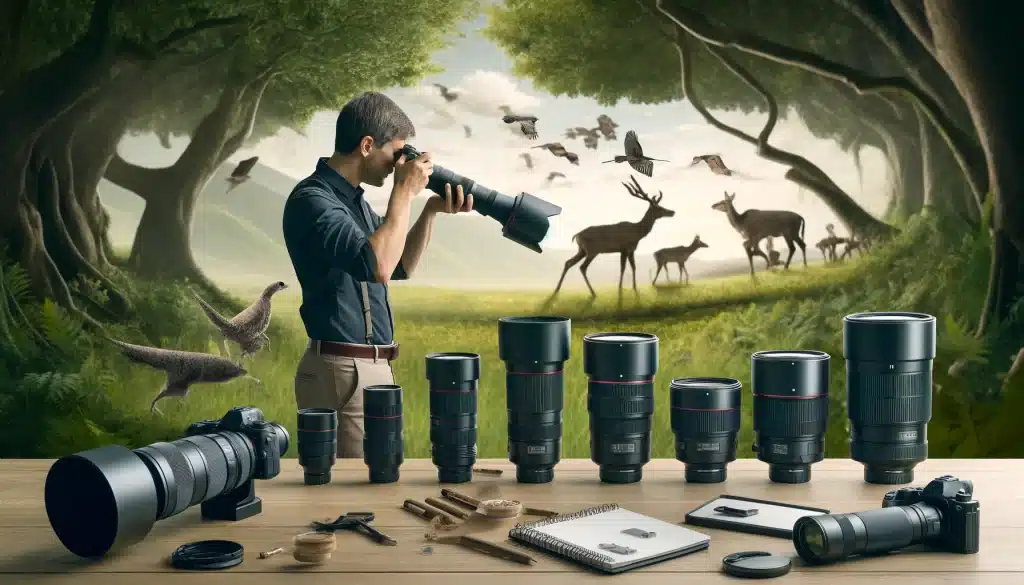
It typically measured in millimeters (mm), is a critical concept in picturing, especially when dealing with telephoto lenses. It defines the lens’s angle of view and how much of the scene will be captured. Here’s how it play out in telephoto lenses:
Wide-Angle to Tele Photography Range
- Wide-angle lenses (23mm-35mm) offer a broad view and are suitable for capturing expansive scenes. Moving up the scale, standard lenses (35mm-55mm) provide a view similar to the human eye, ideal for general shooting.
- Telephoto lenses start from around 70mm and can go beyond 300mm, bringing distant subjects closer and making them appear larger in the frame.
Telephoto Lenses and Field of View
- The longer the focal length, the narrower the field of view. This characteristic makes tele photography lenses perfect for isolating subjects from their background, creating a compressed and focused effect on the captured subject.
- Focal lengths exceeding 300mm are designated as super-telephoto, renowned for their extensive reach and ability to capture intricate details of distant subjects. These lenses are indispensable tools in wildlife or sports photography, enabling photographers to precisely capture the nuances of far-off subjects with remarkable clarity and detail.
Crop Factor and Effective Focal Length
- The crop factor is essential when considering focal lengths, especially with cameras that have smaller sensors than full-frame (35mm) sensors. It refers to the ratio of the sensor size to a full-frame sensor.
- For example, a camera with a 1.5× crop factor will make a 50mm lens behave like a 75mm lens on a full-frame camera. This change affects how the lens's focal length appears on the sensor, essentially 'cropping' the image to a narrower field of view.
Practical Considerations
- Choosing the right telephoto lens depends on your photographic needs. For instance, lenses in the 70-200mm range are versatile for events, portraits, and some sports shooting. In contrast, lenses with focal lengths of 300mm or more are better suited for capturing subjects from a significant distance, like wildlife or distant landscapes.
- Understanding the nuances of focal length helps in selecting the appropriate telephoto lens for your specific type of photograph, be it sports, wildlife, or any other genre that requires magnification of distant subjects.
It significantly impacts the lens’s utility and suitability for various shooting genres. Telephoto lenses, with their long focal lengths, are indispensable for capturing distant subjects, providing both magnification and the ability to compress and focus on specific aspects of the scene.
Autofocus Capabilities in Telephoto Lenses

Telephoto lenses are equipped with advanced autofocus (AF) systems that enhance their ability to capture clear, sharp photos, especially at long distances. These systems are crucial for tracking and maintaining focus on distant or speedy-moving subjects.
Key Aspects of Tele Photography Lens AF
- Speed and Precision: Telephoto lenses often feature fast and accurate autofocus systems, enabling quick focus acquisition on distant subjects.
- Motor Types: The lenses may use ultrasonic motors (USM) or stepping motors (STM) for quiet and smooth focusing, ideal for both still photography and video recording.
- Focus Range and Limiters: Some tele photography lenses include focus range limiters that allow photographers to shorten the autofocus range for faster focusing performance in specific situations.
Advanced AF Features
- Phase Detection: This method, common in DSLRs and many mirrorless cameras, quickly calculates the distance to the subject for rapid focus adjustments.
- Continuous AF Tracking: Essential for capturing action, continuous AF mode keeps moving subjects in sharp focus throughout the shooting sequence.
Considerations for Usage
- Low Light Performance: Telephoto lenses with wide apertures and effective AF systems perform better in low light, maintaining focus accuracy even in challenging conditions.
- Lens and Camera Compatibility: Ensure the tele photography lens’s AF capabilities are compatible with your camera body for optimal performance.
The autofocus capabilities of telephoto lenses are pivotal for capturing distant subjects with clarity and detail. Advances in AF technology have made these lenses more versatile and reliable across a Variety of photographic scenarios.
Image Stabilization (IS) in Tele Photography Lenses
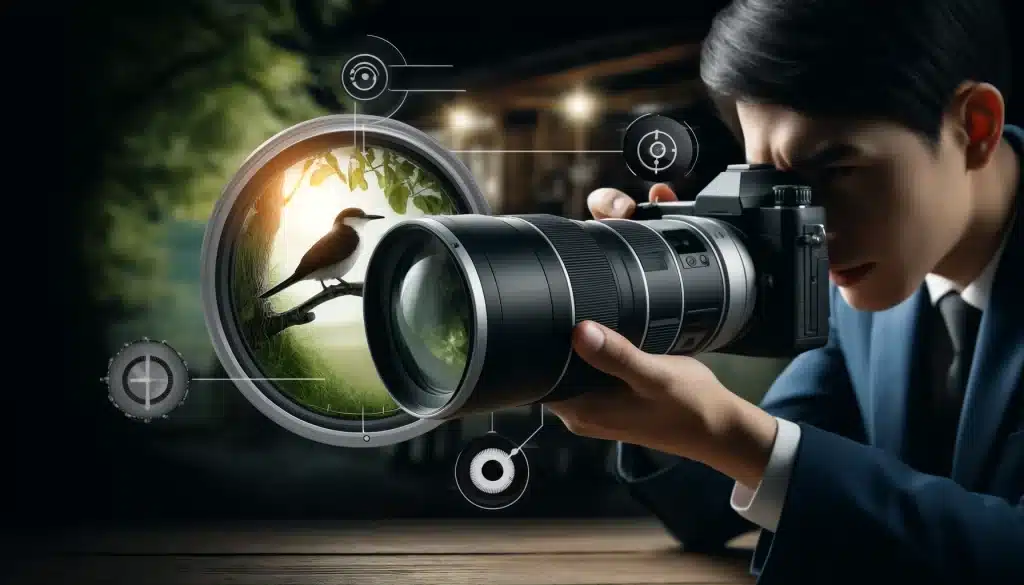
IS in telephoto lenses is crucial for capturing sharp photos by countering camera shake, especially when shooting at long focal lengths or in low light conditions. There are two primary types of IS: Optical Image Stabilization (OIS) and Sensor-shift Image Stabilization.
Optical Image Stabilization (OIS)
- OIS works by adjusting the lens elements or the sensor in the opposite direction to the detected movement, using mechanisms like gyroscopes and housed motors.
- This type is effective for real-time stability, providing clearer photos in the viewfinder and aiding in more accurate autofocus.
Sensor-shift IS
- Sensor-shift stabilization moves the camera's sensor to compensate for camera shake. While effective, it may not provide real-time stability in the viewfinder, which can affect framing and composition, especially in longer lenses.
- This form of stabilization is advantageous because it provides IS with any lens used on the camera, making it a cost-effective solution for those with multiple lenses.
Both OIS and Sensor-shift IS having their benefits, with OIS offering real-time stabilization and Sensor-shift offering flexibility across different lenses. The choice between the two often depends on the specific shooting needs and the camera system in use.
When reviewing IS usage, it’s crucial to consider the photographic context. While IS proves beneficial for handheld shooting, it’s essential to filter its usage when employing a tripod to avoid introducing blur. Additionally, neither form of IS can compensate for motion blur induced by the subject’s movement; they solely correct for camera/lens movement.
Image stabilization emerges as a pivotal feature in telephoto lenses, significantly enhancing image quality by mitigating the detrimental effects of camera shake. Whether utilizing Optical Image Stabilization (OIS) or Sensor-shift technology, each system offers unique advantages that cater to diverse photographic needs and setups.
Telephoto Lenses for Different Photography Genres
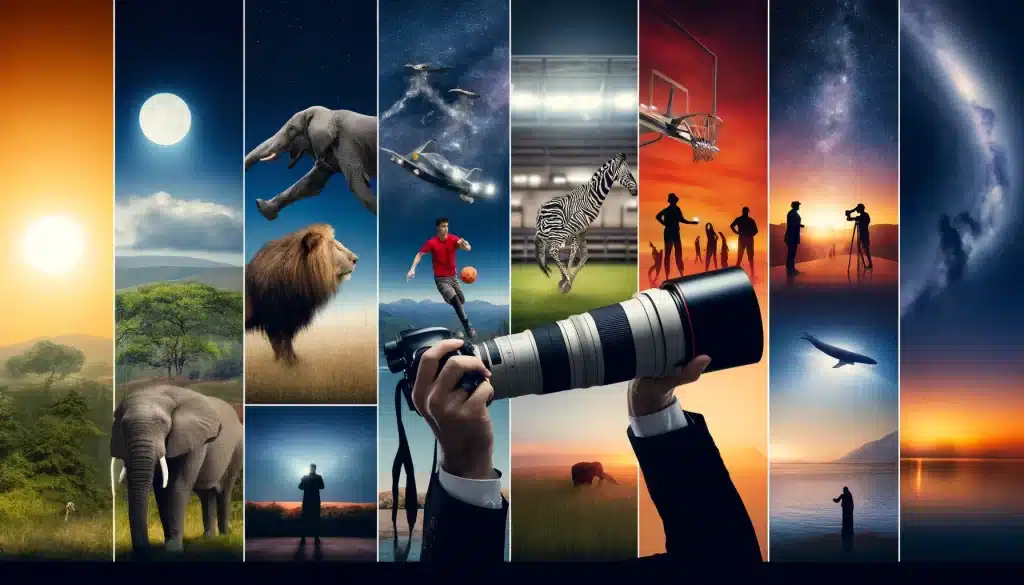
Telephoto lenses provide distinctive capabilities across a spectrum of photography genres. Their capacity to filter and compress distance while isolating subjects from the background renders them invaluable in many contexts.
Wildlife Photography
Telephoto lenses allow photographers to capture detailed photos of animals in their natural environment from a safe distance. They help emphasize the animal against its habitat through background compression and can achieve intimate portraits of wildlife without disturbance.
Sports and Action
In sports and action photograph, telephoto lenses enable photographers to close in on distant subjects and capture fast-speed moments with clarity. They’re essential for freezing action and bringing distant play closer to the viewer, providing a dynamic perspective of the sporting event.
Portrait Photography
Telephoto lenses are favored in portrait photograph for their ability to produce flattering photos with a compressed background. They help isolate the subject from the background, creating a more focused and impactful portrait with a pleasing bokeh effect.
Landscape Photography
While not traditionally associated with landscape photograph, telephoto lenses can filter and isolate specific features of a landscape, such as distant mountains or architectural details. They can compress space and bring distant elements into a more prominent view, adding depth and dimension to the scene.
Astrophotography
For capturing celestial objects like the moon, telephoto lenses with long focal lengths are ideal. They can magnify distant subjects in the night sky, allowing for detailed and impactful photos of astronomical phenomena.
Each photography genre can benefit from the unique properties of tele photography lenses, whether it’s capturing the fine details of distant wildlife, isolating a portrait subject, or compressing a landscape scene to highlight its features. Photographers should consider the specific requirements of their preferred genre to choose the right telephoto lens, balancing factors like focal size, aperture, image balance, and weight to suit their requirements.
Best Telephoto Lenses to Buy on a Budget
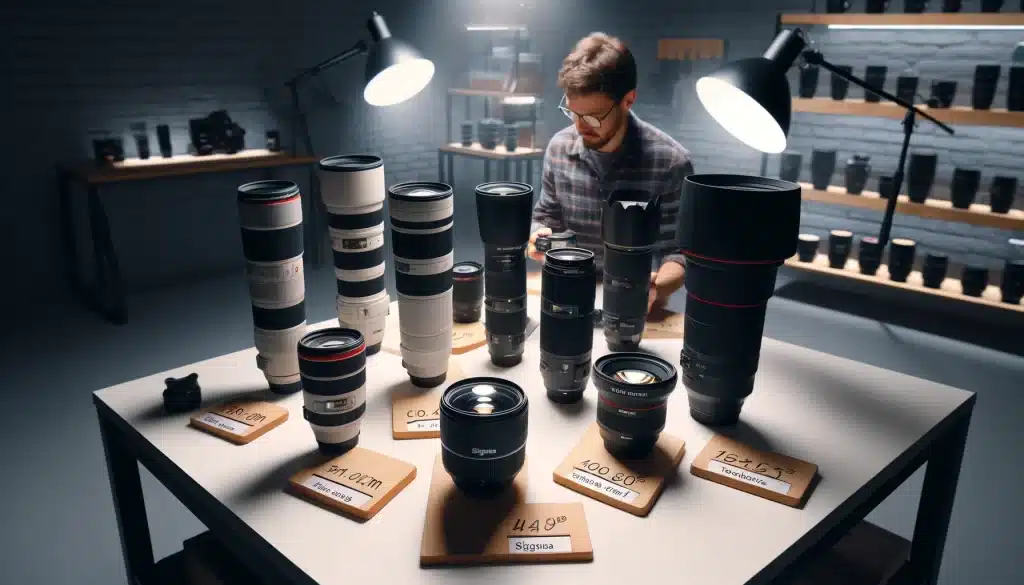
When seeking cost-effective options for telephoto lenses, several models stand out for their balance of price, performance, and features. Here are some notable choices across different brands and camera systems:
Canon RF 100-400mm f/5.6-8 IS USM
- Features: Good sharpness, compatible with EOS R cameras, and has a Nano-USM autofocus motor.
- Pros: Sharp photos, excellent value.
- Cons: Autofocus may miss at times, limited maximum aperture.
- This lens is an excellent budget-friendly option for Canon RF users, offering a decent range and good image quality suitable for wildlife photographs.
Canon RF 800mm f/11 IS STM : Best Telephoto Lens to Buy
- Features: Compact for its focal area, compatible with Canon’s teleconverters, and has a 4-stop image stabilizer
- Pros: Compact design, good handling.
- Cons: Fixed, modest maximum aperture.
- Ideal for Canon users looking for extreme reach without the more cost, especially suitable for astrophotography and distant subjects.
Sigma 100-400mm f/5-6.3 DG DN OS Contemporary
- Features: Available for Sony E and L-mount cameras, offers 5-axis stabilization, and excellent sharpness.
- Pros: Affordable, great stabilization, sharp photos.
- Cons: Limited maximum aperture, no teleconverter support for Sony users.
- This lens provides great versatility and image quality at a budget price, making it a solid choice for Sony and L-mount users.
Tokina AT-X AF SD 400mm F/5.6 : Best Telephoto Lens to Buy
- Features: Compact and lightweight, excellent build quality.
- Pros: Great value, solid build.
- Cons: Fixed focal length, slower aperture.
- An excellent choice for Canon EF users looking for a budget-friendly long reach option.
Canon EF-S 18-135mm F/3.5-5.6 IS STM
- Features: Wide focal area, silent autofocus motor, in-lens stabilization.
- Pros: Versatile focal area, quiet autofocus.
- Cons: Slower maximum aperture at the tele end.
- Perfect for extending the capabilities of Canon APS-C mirrorless kits, offering a good balance between reach and portability.
These lenses demonstrate that quality tele photography capabilities can be accessible without a hefty price tag, making them excellent choices for photographers looking to expand their shooting area while adhering to a budget.
Best Tele Photography Lens to Buy for Wildlife Photography
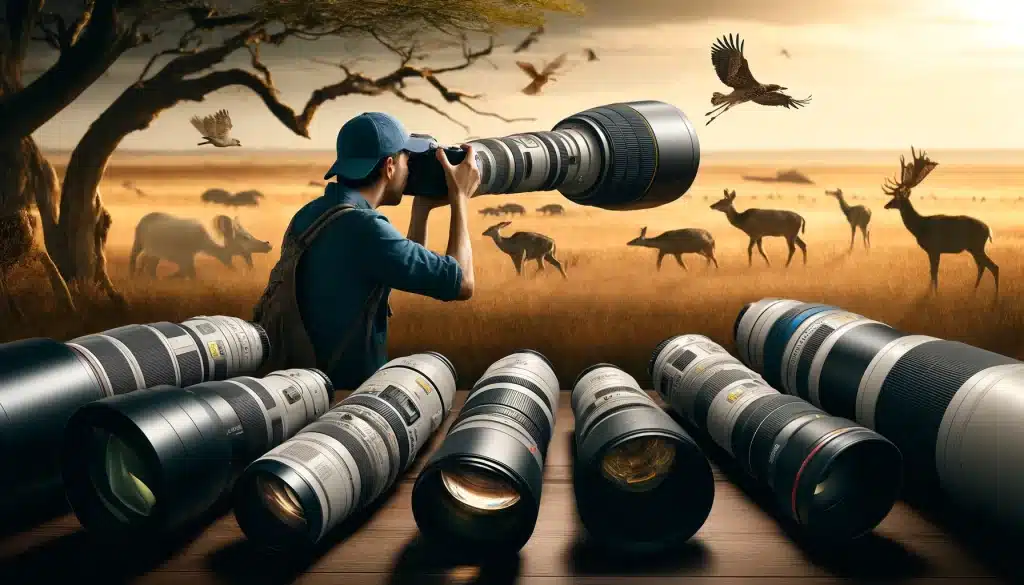
It demands lenses that can handle the challenges of capturing distant, often fast-moving subjects under various environmental conditions. Here are some top lens recommendations tailored for these photographs, considering factors like focal size, image balance, and overall performance.
Nikon AF-S FX 200-500mm f/5.6 ED VR
This Nikon lens is ideal for this photography due to its long focal size and effective vibration reduction (VR) system, allowing for sharp photos even at slower shutter speeds. The constant f/5.6 aperture across the zoom range helps maintain consistent exposure levels in varying light conditions. It’s particularly suited for bird photograph and capturing animals from a safe distance.
Sony FE 200-600mm f/5.6-6.3 ED G OSS
Sony’s offering in the super-telephoto range, this lens provides a versatile focal size suitable for a wide range of wildlife subjects. With its advanced autofocus system and effective image stability, it’s capable of delivering sharp photos in dynamic conditions, making it an excellent all-purpose wildlife lens.
Fujifilm XF 100-400mm f/4.5-5.6R LM OIS WR
Fujifilm users can rely on this lens for its powerful magnification, image stability, and durable build. The lens’s 100-400mm area allows for flexibility in framing and composition, essential for the unpredictable nature of this photography.
Sigma 150-600mm F5-6.3 DG DN OS
For photographers seeking extensive reach without breaking the bank, Sigma’s 150-600mm lens offers a great solution. With a design that balances focal area and handling, it provides the ability to capture detailed shots of distant wildlife. The lens includes optical stabilization and a versatile zoom mechanism for quick framing adjustments.
Sony FE 100-400mm F4.5-5.6 GM OSS
For those prioritizing exceptional image quality and fast autofocus, this Sony lens is a formidable contender. It pairs well with full-frame cameras, offering a reach and optical performance that can handle the demands of professional wildlife photography. Its compatibility with teleconverters also extends its versatility further.
Selecting the right lens for this photography involves balancing the need for reach, speed, and image quality with the physical weight and handling of the lens. These options present various choices for photographers at different levels of expertise and budget, ensuring that there are capable tools available to capture the beauty of the natural world.
Technological Advances in Telephoto Lens Design
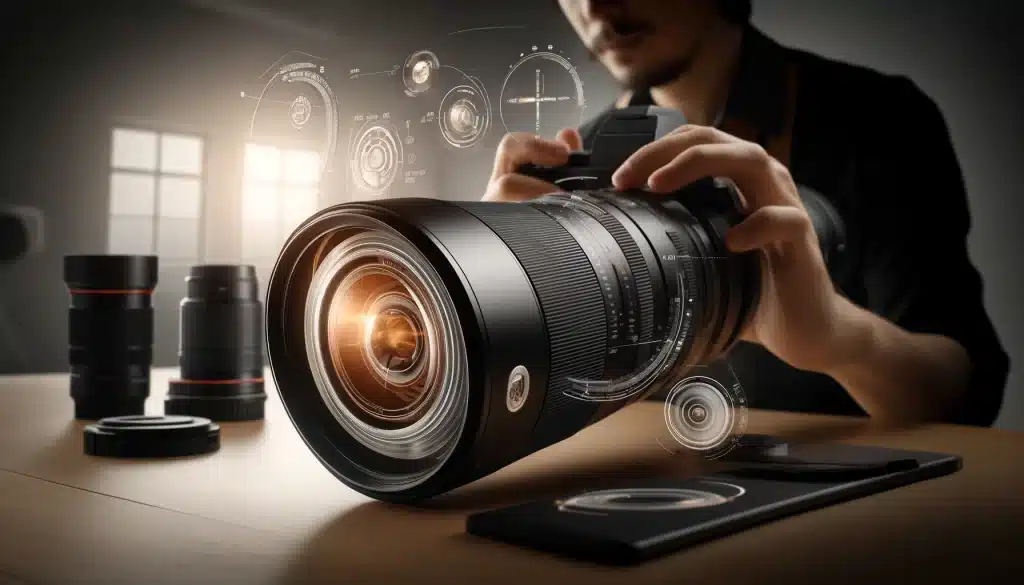
The design and functionality of telephoto lenses have significantly evolved, with manufacturers incorporating advanced technologies to enhance performance and user experience. Key developments include:
Advanced Optical Engineering
Lenses now feature sophisticated optical designs that include aspherical and low dispersion elements, reducing aberrations and increasing sharpness and contrast across the image.
Improved Aperture Control
Modern telephoto lenses offer wider apertures, such as f/2.8, allowing more light intake, better low-light performance, and shallower depth of field for striking bokeh effects.
Enhanced Image Stabilization(IS) Systems
Cutting-edge IS technology in lenses helps photographers achieve sharper images by compensating for hand shake and movement, critical in high-magnification photography.
Refined Autofocus Mechanisms
Autofocus systems have become faster and more accurate, with silent motors like the USM (Ultrasonic Motor) and STM (Stepping Motor) providing quick and quiet focus adjustments, essential for tracking moving subjects seamlessly.
Lightweight and Durable Builds
The use of advanced materials has led to lighter and more robust lens constructions, making telephoto lenses easier to handle and more resilient to environmental challenges.
Integration of Digital Technologies
Features like programmable buttons, electronic displays, and connectivity options have been integrated into lens designs, offering photographers enhanced control and customization.
These advancements in telephoto lens design not only improve the photographic results but also enhance the user experience, enabling photographers to capture high-quality images in a diverse range of shooting conditions.
Why Invest in a Telephoto Lens?

When considering adding a telephoto lens to your camera gear, you’re essentially broadening your creative toolkit, allowing yourself to delve into a world of photography that goes beyond the limitations of standard lenses. Let’s explore in detail:
Explore New Perspectives
It offers a unique way to explore scenes and subjects from a fresh perspective. By bringing distant objects closer, they allow you to discover details and compositions that may have gone unnoticed before. This opens up a whole new world of photographic possibilities, whether you’re shooting landscapes, urban scenes, or portraits.
Capture Candid Moments from Afar
One of the most valuable aspects of it is their ability to capture candid moments from a distance without disturbing the scene. This is particularly useful in event photograph, where you want to document genuine emotions and interactions without intruding on the moment. With it, you can blend into the background and observe without being obtrusive.
Create Stunning Portraits
They are renowned for their flattering perspective and ability to produce beautiful portrait shots. By compressing the background and isolating the subject, they create a sense of intimacy and focus that enhances the overall impact of the image. Whether you’re shooting individual portraits or group shots, a telephoto lens can elevate your portrait photographing to the next level.
Enhance Street Photography
In this, capturing authentic moments and expressions often requires maintaining a certain distance from your subjects. It allow you to do just that while still bringing your subjects up close in your frame. This enables you to capture candid moments on busy streets without disrupting the flow of the scene.
Experiment with Creative Composition
It offers endless opportunities for experimenting with composition. By isolating specific elements within a scene, you can create visually striking images that draw the viewer’s eye and evoke emotion. Whether you’re focusing on patterns, textures, or contrasts, it enable you to unleash your creativity and see the world in a whole new way.
Capture Details with Precision
Whether you’re photographing architecture, landscapes, or wildlife, telephoto lenses allow you to capture intricate details with precision. By zooming in on specific features or points of interest, you can create images that are rich in texture and depth, revealing the beauty of even the smallest details.
Adapt to Challenging Lighting Conditions
Many telephoto lenses feature wide apertures that excel in low-light situations, allowing you to maintain fast shutter speeds and freeze motion even in challenging lighting conditions. This versatility enables you to shoot confidently in various environments, from dimly lit interiors to outdoor scenes during the golden hour.
Expand Your Creative Horizons
Investing in it isn’t just about expanding your gear collection—it’s about expanding your creative horizons. With this lens in your arsenal, you’ll be inspired to see the world in a new light and capture images that truly resonate with your artistic vision. Whether you’re a seasoned photographer or just starting out it has the power to transform your photography journey.
Frequently Asked Questions : Best Telephoto Lens to Buy

Which lens has the greatest telephoto effect?
The Canon EF 800mm f/5.6L IS USM and Sigma 300-800mm f/5.6 EX DG APO IF HSM are renowned for their exceptional telephoto reach. These lenses offer extraordinary magnification, allowing photographers to capture distant subjects with remarkable clarity and detail. The Canon EF 800mm f/5.6L IS USM, in particular, boasts advanced optical technology that ensures high-quality images even at extreme distances. With their long focal lengths, these lenses are indispensable tools for photographers who specialize in wildlife, sports, or astrophotography, where capturing distant subjects is paramount.
What are the 3 important qualities of a tele photography lens?
- Focal Length: Telephoto lenses feature longer focal lengths, allowing for closer views of distant subjects. This magnification power is crucial for bringing far-off subjects within reach, enabling photographers to capture intricate details with precision.
- Image Quality: Sharpness, contrast, and color rendition are fundamental aspects of image quality in tele photography lenses. These lenses are designed to deliver high-resolution images with minimal distortion and aberrations, ensuring that distant subjects are rendered with clarity and accuracy.
- Autofocus Performance: Fast and accurate autofocus is essential for tracking moving subjects, a common requirement in telephoto photography. Telephoto lenses often feature advanced autofocus systems with rapid focus acquisition and tracking capabilities, enabling photographers to maintain sharp focus on dynamic subjects, such as wildlife or sports athletes, even at long distances.
Which is better, zoom or telephoto lens?
Choosing between a zoom and tele photography lens depends on your specific shooting needs and preferences. Tele photography lenses offer fixed focal lengths, providing significant magnification and clarity for capturing distant subjects. They excel in scenarios where reaching far-off subjects is essential, such as wildlife or sports photography. On the other hand, zoom lenses provide variable focal lengths, offering versatility and flexibility to frame shots at different magnifications without changing lenses. They are ideal for photographers who require adaptability in their shooting environments, such as event or travel photographers. Ultimately, the choice between zoom and telephoto lenses depends on factors like the intended use, shooting style, and budget.
What is the best lens for long-distance photography?
For long-distance photography, the Nikon AF-S FX 200-500mm f/5.6 ED VR stands out as an excellent choice. Offering a versatile focal range and effective vibration reduction (VR) system, this lens enables photographers to capture sharp images of distant subjects with ease. Its constant f/5.6 aperture ensures consistent exposure levels, even in challenging lighting conditions, making it ideal for wildlife, sports, and nature photography.
Final Thoughts : Best Telephoto Lens to Buy
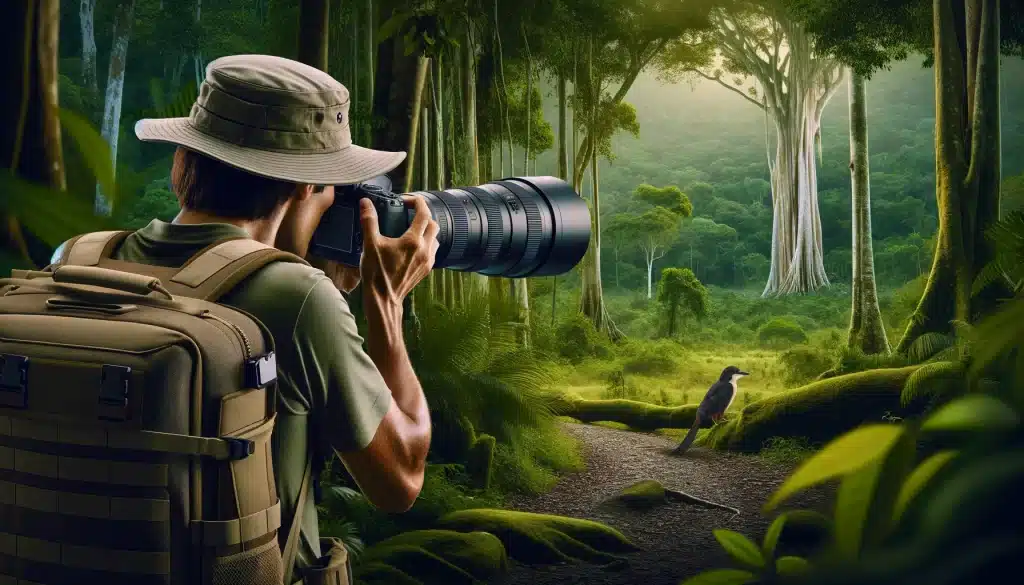
In my photography journey, I’ve discovered the transformative power of choosing the right lens. A trek through the Amazon with my 200-500mm lens showcased its magic, capturing distant creatures without disturbance. It emphasized the need for long reach, sharpness, and fast autofocus. Each adventure shows the value of choosing the best lens for the job.
Enhance your photography skills with adobe photoshop and Lightroom courses, encompassing both technical and artistic aspects. Dive deep into the world of image creation with our Photoshop Course and Lightroom Course.
These will not only help you understand the nuances of your photography equipment, including telephoto lenses, but also guide you in mastering post-processing to bring your visions to life.
If the “Best Telephoto Lens to Buy” article has helped you, then Like and Share it with your friends!
Have a nice photoshoot!
Learn more about Photography Equipment:

